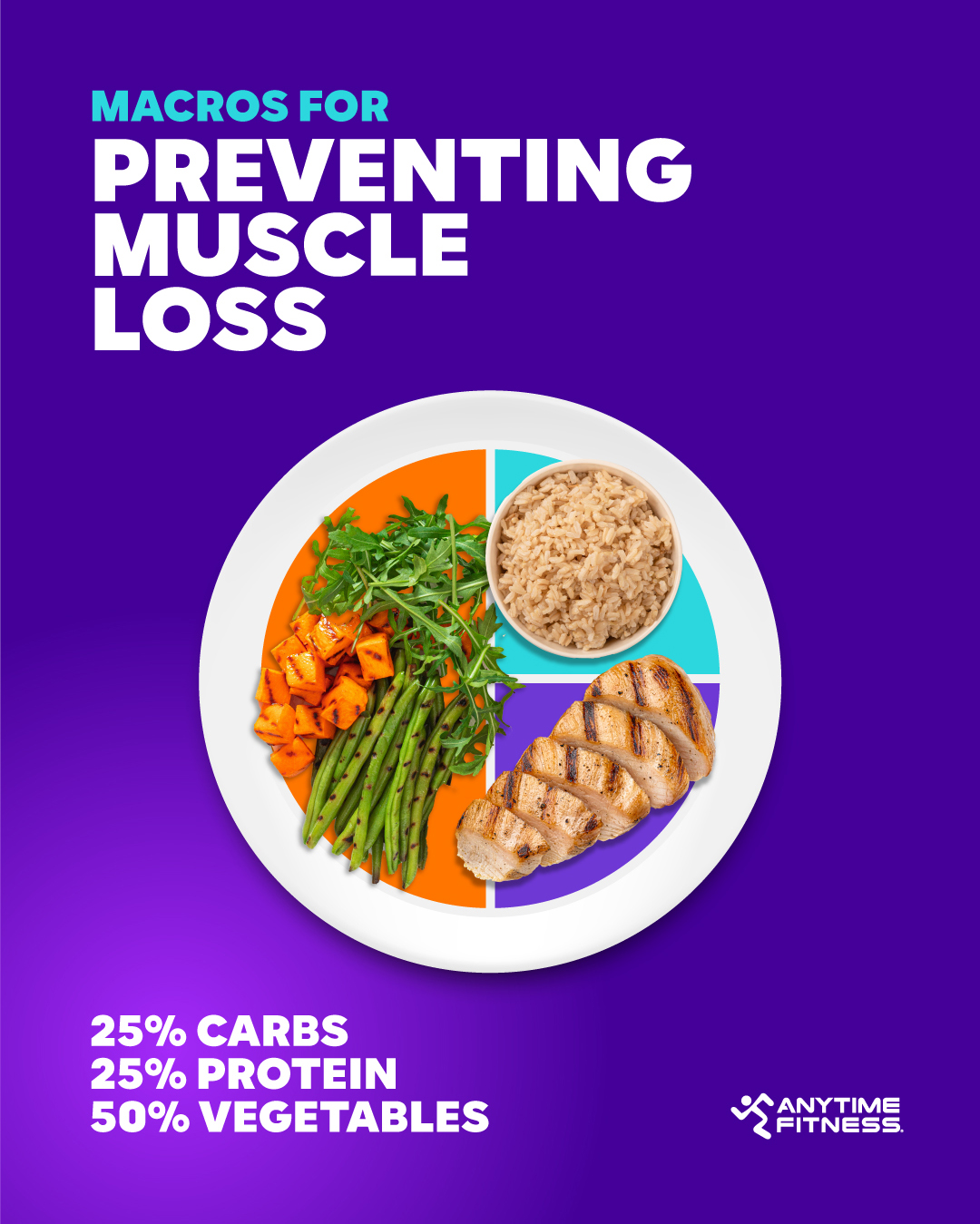GLP-1 medications, which were previously only prescribed to treat obesity and type 2 diabetes, have recently been growing in popularity for general weight loss. Yet taking a GLP-1 medication alone won’t yield the weight-loss results that these drugs are known for. To achieve and sustain GLP-1 weight loss, it’s important to support your body with a nutrient-dense diet and regular exercise. But what does a GLP-1 weight-loss workout plan look like? And should your routine change when taking a weight-loss medication? Let’s talk about it!
We’ll cover:
- The effects of GLP-1 medications
- GLP-1 muscle loss and how to prevent it
- GLP-1 and exercise
- 3 tips to create an effective GLP-1 weight-loss workout plan
The effects of GLP-1 medications
Taken as prescribed with regular exercise and a nutrient-rich diet, GLP-1 medications can help:
- Increase weight loss
- Lower blood pressure
- Regulate blood sugar levels
- Reduce the risk of cardiovascular diseases
GLP-1s may also lead to side effects such as:
- Nausea and upset stomach
- Loss of appetite
- Dizziness and headaches
GLP-1s and muscle loss
Another potential side effect of GLP-1 drugs: muscle loss. Whether you’re taking a GLP-1 medication or not, your body needs energy in the form of calories to maintain muscle mass. Because of the appetite-suppressing effects of GLP-1 medications, consuming enough food to meet your body’s daily needs can be a challenge. On top of that, rapid weight loss can also lead to a decrease in muscle mass, which can negatively affect your strength, stamina, and metabolism and make you more prone to injury.
That sounds like a lot of negativity, but GLP-1s can be an effective tool for sustainable weight loss with the right support. To talk about how nutrition and your exercise routine can prevent GLP-1 muscle loss, we tapped AF Nutrition Coach Gianna Masi, RDN, CISSN, CPT, for her expertise.
What percentage of weight loss is diet vs. exercise?
“Diet and exercise are often discussed as a pair, but I encourage everyone to uncouple the two,” says Masi. “Neither is more important than the other because they are both crucial to our health, body composition, and muscle mass. We need both to achieve our desired goals and health outcomes.”
Achieving weight loss ultimately comes down to maintaining a calorie deficit. In other words: burning more calories than you consume in a day. You can achieve a calorie deficit by reducing your daily calorie intake or increasing your exercise and activity levels — this may change from day to day, depending on your schedule, dietary needs, or workout plan.
Because taking a GLP-1 medication suppresses your appetite and typically lowers your daily calorie intake, it’s important to focus on fueling your body with a nutrient- and protein-rich diet to power your workout routine. Masi explained how to maintain muscle mass and support your body on a GLP-1 diet in this blog, so let’s turn our attention to GLP-1 weight loss through exercise.
GLP-1s and exercise
The current Physical Activity Guidelines for Americans recommend 150 minutes of moderate physical activity per week, with at least two days of strength training. On a GLP-1 medication, your balance of cardio and strength training should look a little different.
“Aerobic training and resistance training must remain a staple in someone’s week in order to maintain endurance and as much muscle mass as possible while they are in a calorie deficit on the GLP-1 medication,” Masi advises. Her top tip: Continue to train in ways you enjoy — and if your routine doesn’t already include resistance or strength training, find ways to add it in at least three times a week.
Cardio for weight loss

If you’re trying to maintain a calorie deficit by increasing your daily calorie burn, cardio is a great way to start. Depending on the type and intensity of your workout, cardio can burn anywhere from 200 to 600 calories per hour. Common forms of cardio include:
- Running
- Hiking
- Biking
- Swimming
- Rowing
- Dancing
- Stair climbing
- Recreational sports
In addition to supporting weight loss, cardio can improve your heart and lung health, increase stamina and strength, reduce your risk of chronic diseases, and boost your mood and mental health. Aim for three to four 30- to 50-minute cardio sessions per week for weight loss.
Strength training for weight loss

While cardio is known for its weight-loss benefits, strength training is just as important in a GLP-1 workout routine. Masi notes, “Aerobic (cardio) fitness alone is not enough to stimulate muscle tissue for muscle growth, which is why resistance training is so important alongside aerobic work.”
Supplementing your workout routine with strength training is key to maintaining muscle mass and sustaining your results while taking a GLP-1 medication. Resistance training increases strength, improves balance and coordination, enhances your ability to do everyday tasks, and decreases your risk of injury. On top of that, increasing muscle mass can actually help your body burn more calories at rest, getting you closer to your weight-loss goals.
Types of strength training include:
- Lifting weights
- Using gym equipment like leg press and extension machines
- Resistance band workouts
- TRX workouts
- Calisthenics and bodyweight workouts
Aim for at least three strength workouts per week to maintain and build muscle mass. Try one of these strength workouts:

Bonus: Fuel your workout routine with macros
If you’re focusing on strength training for weight loss, tracking your macros could be a helpful way to support your fitness goals.
Masi suggests a plate filled with ¼ protein, ¼ carbohydrates, and ½ vegetables to start. 20 to 40 grams of lean protein at each meal is a general guideline for meeting your macro needs, depending on your current weight and goals. To get a personalized recommendation, talk to an Anytime Fitness Coach or other professional, like a dietitian.
Does exercise increase GLP-1?
Did you know that GLP-1 is a naturally occurring hormone? GLP-1 medications work by mimicking the real hormone to induce its effects. So, how do you increase GLP-1 naturally? Research is limited, but one study showed that some forms of exercise could increase the levels of GLP-1 in your system. Masi adds, “GLP-1 levels can naturally increase with exercise and training, but they do not rise to anywhere near the same level as they would on a GLP-1 medication.”
Do GLP-1s have cardiovascular benefits?
In addition to promoting weight loss, GLP-1 medications can also improve cardiovascular health, particularly in people with type 2 diabetes or obesity. “Over time, with weight loss or better blood sugar management, potential cardiovascular improvements can include lower blood pressure, improved lipid labs, reduced inflammation, and improved insulin sensitivity,” Masi says.
Taking a GLP-1 medication alone, however, will not yield the same cardiovascular benefits as regular exercise supplemented by a GLP-1 medication. Exercise is a necessary part of improved cardiovascular health.
Measure your progress with body composition scans
Progress in the gym goes beyond the number on the scale. One of the best ways to get a full picture of your weight-loss journey is with a body composition scan. Available at many Anytime Fitness locations, the Evolt 360 body composition scanner offers more than 40 metrics — like body fat percentage and water weight — that can help you measure your progress and make informed changes to your training, nutrition, and recovery program.
The Evolt also measures lean muscle mass and skeletal muscle mass, two key metrics to monitor on a GLP-1 weight-loss program. GLP-1 muscle loss doesn’t just affect the muscles we can see (skeletal muscle), but it also reduces the amount of lean muscle mass (made up of muscles, bones, and organs) in your body. Tracking both metrics gives you a better picture of your overall health than measuring skeletal muscle mass alone. Based on this information, you can adjust your training and nutrition plan — and an Anytime Fitness Coach can give you personalized guidance.
4 tips for an effective GLP-1 weight-loss workout plan
- Focus on strength training. A balanced, effective GLP-1 weight-loss workout program includes a mix of cardio and strength training to counteract the effects of the medication. Plus, increasing muscle mass can actually help your body burn more calories, even at rest.
- Stay in tune with your body. “Since GLP-1 can alter the hunger/satiety signals, it’s important to be aware of meals and snacks that you eat throughout the day,” Masi says. Use these tips to listen to your hunger and fullness cues, and pay attention to how your body is feeling after a workout. Overly tired? Time to dial it back or fuel up to power your workout. Not feeling challenged? Try increasing your weights and rep counts.
- Follow a schedule. Consistency is key to getting results. Masi says that having a meal schedule (even a flexible one) can help you maintain steady energy and maximize protein synthesis to sustain muscle mass. The same goes for workouts — getting into a routine can help you achieve more efficient weight-loss results.
- Track your workouts. Tracking your workouts in a notebook or the Anytime Fitness App not only keeps you accountable and motivated, but it can also help you know when and how to adjust your training and nutrition plans. Plus, you get to see your progress over time, from increased reps to faster mile splits to improved endurance. That’s cause for celebration!
A final word on GLP-1 muscle loss
So, should your exercise routine change on a GLP-1 medication? Regular exercise is always important, but it’s especially critical to your success on a GLP-1. This helps to prevent muscle loss and keeps your body functioning properly. If your fitness routine doesn’t already include strength training, adding at least three sessions per week could take good results to the next level for sustainable, impactful weight loss.
It may take some time to understand how your body responds to weight-loss treatments and adjust your training routine accordingly. Weight loss is a process that happens over time and with consistency. Remember to listen to your body along the way and be patient as you wait to see the results of your hard work.
More weight-loss resources
A comprehensive training, nutrition, and recovery plan can help you achieve better weight-loss results, faster. Team up with an Anytime Fitness Coach to get the personalized resources you need to support your body, no matter your fitness goals.



